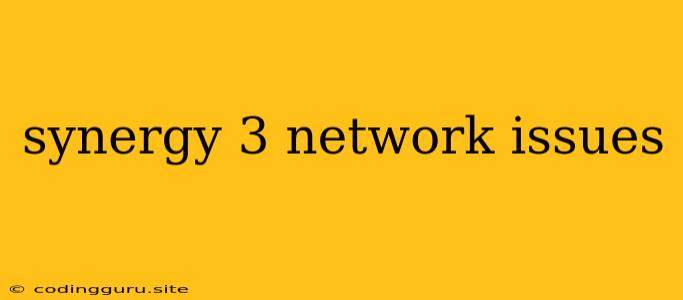Synergy 3 Network Issues: Troubleshooting and Solutions
Synergy 3, a powerful tool for controlling multiple computers with a single mouse and keyboard, can sometimes encounter network issues. This can be frustrating, especially when you rely on this setup for your workflow. Luckily, most of these problems can be solved with some troubleshooting steps.
Understanding the Problem:
Before we dive into solutions, it's important to understand what exactly is causing the network issue. Here are some common symptoms:
- Slow response: Your mouse movements or keyboard inputs lag behind on the remote computer.
- Disconnection: The connection between your primary and remote computers is abruptly lost.
- No connection: Synergy 3 doesn't recognize your remote computer at all.
Troubleshooting Steps:
Here are some steps you can take to troubleshoot and fix Synergy 3 network issues:
1. Check Network Connectivity
- Basic Connection: The most obvious step is to ensure that your primary and remote computers are connected to the same network. This can be a wired or wireless network.
- Firewall and Antivirus: Make sure your firewall and antivirus software aren't blocking Synergy 3. Temporarily disable them to see if that resolves the issue.
- IP Address: If you are using static IP addresses, ensure they are correctly configured on both your primary and remote computers.
2. Restart and Update
- Restart Synergy: Sometimes, simply restarting Synergy 3 on both the primary and remote computers can resolve minor issues.
- Update Synergy: Ensure you have the latest version of Synergy 3 installed on all computers. Updates often include bug fixes and performance improvements.
3. Server Configuration
- Server and Client Roles: Ensure that your primary computer is correctly set as the server and the remote computers are set as clients in the Synergy 3 configuration.
- Firewall Ports: Make sure the necessary ports (usually 24800 for TCP and 24801 for UDP) are open on both the server and client machines.
- Server Location: If the server is on a different network, make sure your router is properly configured to allow communication between the two networks.
4. Network Settings
- Network Speed: If you are using a slow network connection (like a shared Wi-Fi network), Synergy 3 might experience lag. Try to connect both computers to a faster network.
- Network Interference: Other applications or devices on your network might interfere with Synergy 3. Try disabling other network-intensive applications.
5. Advanced Troubleshooting
- Check Logs: Synergy 3 generates log files that can provide insights into any issues. These logs are usually located in the application's installation directory.
- Remote Access Software: If you suspect a problem with your network configuration, try using a different remote access tool (like TeamViewer) to see if you can access the remote computer.
6. Common Errors and Solutions
- "Synergy Server not responding": This indicates that your server machine isn't functioning properly. Check the server's network configuration, firewall settings, and make sure the server is running correctly.
- "Failed to connect to server": This error implies the client computer cannot find the server. Verify the server's IP address is correct in the client configuration, and ensure the server is running.
- "Invalid Server Address": The specified server address in your client configuration might be incorrect. Double-check the server's IP address or hostname.
Example:
Let's say you have two computers, "Computer A" and "Computer B". You want to use "Computer A" as the primary machine and control "Computer B" remotely. You have both computers on the same Wi-Fi network. Here's how you would configure Synergy 3:
- Server Configuration: On "Computer A," install and launch Synergy 3 and select "Server" in the configuration.
- Client Configuration: On "Computer B", install and launch Synergy 3. In the configuration, select "Client," and enter the IP address of "Computer A" as the server address.
- Start: After saving the configurations, start Synergy 3 on both machines.
- Testing: You should be able to control "Computer B" using the mouse and keyboard on "Computer A."
Conclusion
Synergy 3 network issues can be frustrating but are usually solvable. By following these troubleshooting steps and understanding the potential causes, you can effectively diagnose and fix the problem. If you've tried all the above steps and are still facing issues, it's best to seek help from the Synergy 3 community forums or the official documentation.
